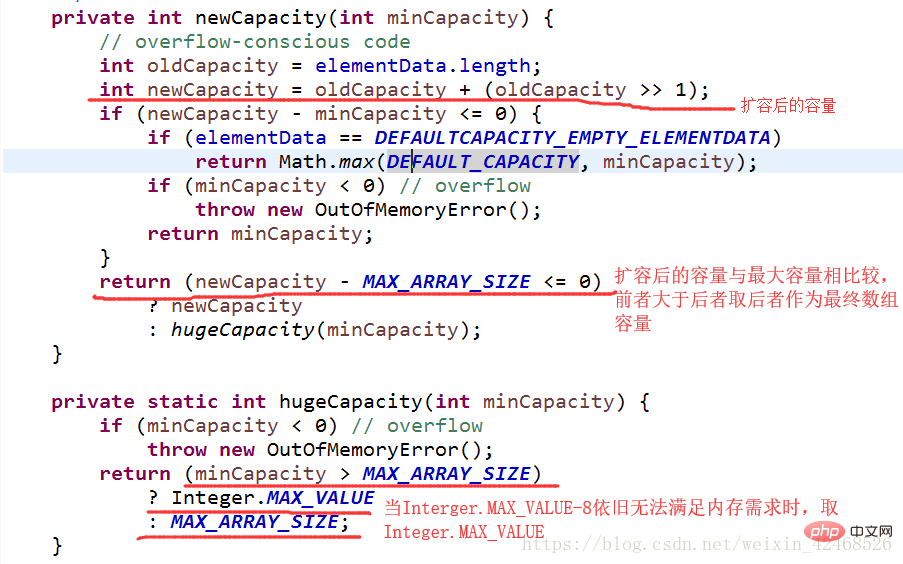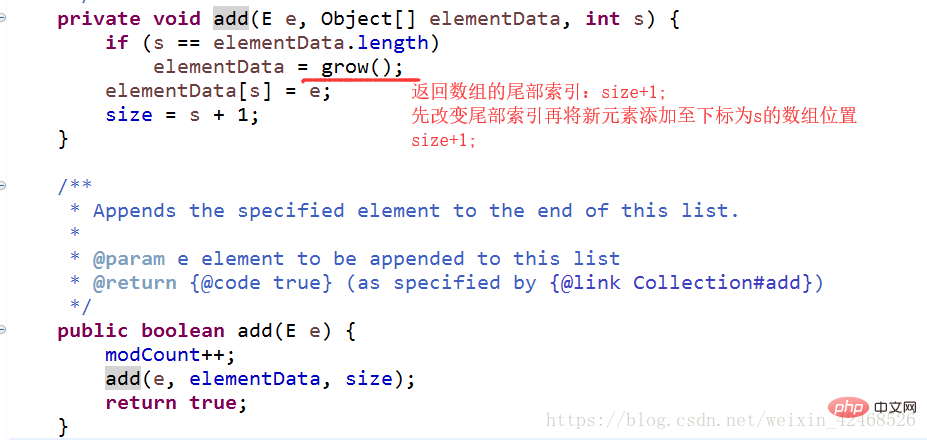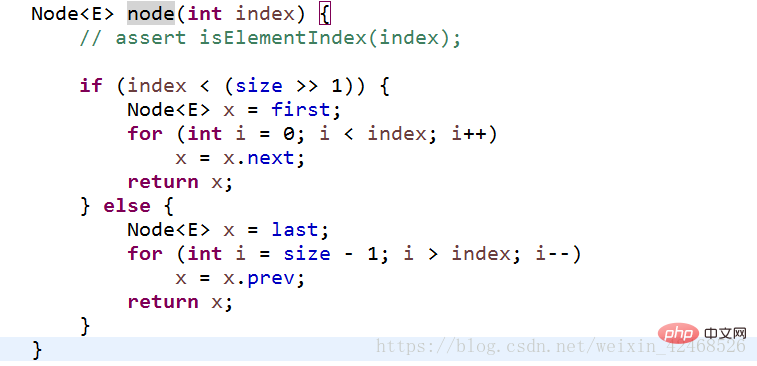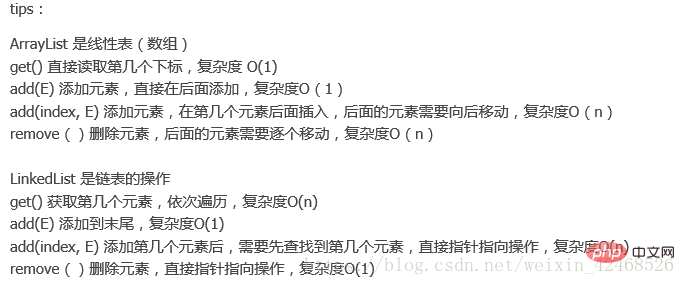The difference between Arraylist and Linkedlist in java interview

Let’s first introduce the knowledge of Arraylist:
(Learning video sharing: java teaching video)
Arraylist: The bottom layer is based on a dynamic array. According to the following table, random access to array elements is highly efficient, and adding elements to the tail of the array is highly efficient;
However, deleting data in the array and adding data to the middle of the array are inefficient. , because the array needs to be moved. For example, the worst case scenario is to delete the first array element, which requires moving the 2nd to nth array elements forward one bit each. The reason why it is called a dynamic array is because Arraylist can be expanded when the array elements exceed its capacity (for JDK1.8, the capacity of the array after expansion is 1.5 times that before expansion). The largest array capacity in the Arraylist source code is Integer .MAX_VALUE-8, for the vacated 8 bits, the current explanation is:
①Storage Headerwords;
②To avoid some machine memory overflows and reduce the chance of errors, so less allocation;
③The maximum can still be supported is Integer.MAX_VALUE (when Integer.MAX_VALUE-8 still cannot meet the demand).
The following is part of the source code of Arraylist: Arraylist expansion:

(More interview questions to share: java interview questions and answers)
Add data to Arraylist: (Add to the end of the array)

#Add an array to the specified position of the array:

It can be seen that as long as the current capacity of ArrayList is large enough, the add() operation to the end of the array is very efficient. When adding data to the specified position of the array, a large number of array moving and copying operations will be performed. When the array is copied, the System.arraycopy() method will eventually be called, so the efficiency of the add() operation is still quite high. Even so, when adding data to a specified location, it is still slower than Linkedlist, which only needs to change the pointer to add data. Deleting an array in Arraylist also requires moving the array, which is slower.
Linkedlist is a dynamic array based on linked lists. Data addition and deletion are efficient and only need to change the pointer. However, the average efficiency of accessing data is low and the linked list needs to be traversed. Arraylist get data source code: (according to subscript access, high efficiency)

Linkedlist access data source code: (node() function traverses the linked list)


Summary:
1. For random access get and set, ArrayList is better than LinkedList because LinkedList needs to move the pointer.
For the new and deletion operations add and remove, LinedList has the advantage because ArrayList needs to move data.
2. Respective efficiency issues:

Related recommendations: java introductory tutorial
The above is the detailed content of The difference between Arraylist and Linkedlist in java interview. For more information, please follow other related articles on the PHP Chinese website!

Hot AI Tools

Undresser.AI Undress
AI-powered app for creating realistic nude photos

AI Clothes Remover
Online AI tool for removing clothes from photos.

Undress AI Tool
Undress images for free

Clothoff.io
AI clothes remover

Video Face Swap
Swap faces in any video effortlessly with our completely free AI face swap tool!

Hot Article

Hot Tools

Notepad++7.3.1
Easy-to-use and free code editor

SublimeText3 Chinese version
Chinese version, very easy to use

Zend Studio 13.0.1
Powerful PHP integrated development environment

Dreamweaver CS6
Visual web development tools

SublimeText3 Mac version
God-level code editing software (SublimeText3)

Hot Topics
 1669
1669
 14
14
 1428
1428
 52
52
 1329
1329
 25
25
 1273
1273
 29
29
 1256
1256
 24
24
 PHP: A Key Language for Web Development
Apr 13, 2025 am 12:08 AM
PHP: A Key Language for Web Development
Apr 13, 2025 am 12:08 AM
PHP is a scripting language widely used on the server side, especially suitable for web development. 1.PHP can embed HTML, process HTTP requests and responses, and supports a variety of databases. 2.PHP is used to generate dynamic web content, process form data, access databases, etc., with strong community support and open source resources. 3. PHP is an interpreted language, and the execution process includes lexical analysis, grammatical analysis, compilation and execution. 4.PHP can be combined with MySQL for advanced applications such as user registration systems. 5. When debugging PHP, you can use functions such as error_reporting() and var_dump(). 6. Optimize PHP code to use caching mechanisms, optimize database queries and use built-in functions. 7
 PHP vs. Python: Understanding the Differences
Apr 11, 2025 am 12:15 AM
PHP vs. Python: Understanding the Differences
Apr 11, 2025 am 12:15 AM
PHP and Python each have their own advantages, and the choice should be based on project requirements. 1.PHP is suitable for web development, with simple syntax and high execution efficiency. 2. Python is suitable for data science and machine learning, with concise syntax and rich libraries.
 Break or return from Java 8 stream forEach?
Feb 07, 2025 pm 12:09 PM
Break or return from Java 8 stream forEach?
Feb 07, 2025 pm 12:09 PM
Java 8 introduces the Stream API, providing a powerful and expressive way to process data collections. However, a common question when using Stream is: How to break or return from a forEach operation? Traditional loops allow for early interruption or return, but Stream's forEach method does not directly support this method. This article will explain the reasons and explore alternative methods for implementing premature termination in Stream processing systems. Further reading: Java Stream API improvements Understand Stream forEach The forEach method is a terminal operation that performs one operation on each element in the Stream. Its design intention is
 PHP vs. Other Languages: A Comparison
Apr 13, 2025 am 12:19 AM
PHP vs. Other Languages: A Comparison
Apr 13, 2025 am 12:19 AM
PHP is suitable for web development, especially in rapid development and processing dynamic content, but is not good at data science and enterprise-level applications. Compared with Python, PHP has more advantages in web development, but is not as good as Python in the field of data science; compared with Java, PHP performs worse in enterprise-level applications, but is more flexible in web development; compared with JavaScript, PHP is more concise in back-end development, but is not as good as JavaScript in front-end development.
 PHP vs. Python: Core Features and Functionality
Apr 13, 2025 am 12:16 AM
PHP vs. Python: Core Features and Functionality
Apr 13, 2025 am 12:16 AM
PHP and Python each have their own advantages and are suitable for different scenarios. 1.PHP is suitable for web development and provides built-in web servers and rich function libraries. 2. Python is suitable for data science and machine learning, with concise syntax and a powerful standard library. When choosing, it should be decided based on project requirements.
 PHP's Impact: Web Development and Beyond
Apr 18, 2025 am 12:10 AM
PHP's Impact: Web Development and Beyond
Apr 18, 2025 am 12:10 AM
PHPhassignificantlyimpactedwebdevelopmentandextendsbeyondit.1)ItpowersmajorplatformslikeWordPressandexcelsindatabaseinteractions.2)PHP'sadaptabilityallowsittoscaleforlargeapplicationsusingframeworkslikeLaravel.3)Beyondweb,PHPisusedincommand-linescrip
 PHP: The Foundation of Many Websites
Apr 13, 2025 am 12:07 AM
PHP: The Foundation of Many Websites
Apr 13, 2025 am 12:07 AM
The reasons why PHP is the preferred technology stack for many websites include its ease of use, strong community support, and widespread use. 1) Easy to learn and use, suitable for beginners. 2) Have a huge developer community and rich resources. 3) Widely used in WordPress, Drupal and other platforms. 4) Integrate tightly with web servers to simplify development deployment.
 PHP vs. Python: Use Cases and Applications
Apr 17, 2025 am 12:23 AM
PHP vs. Python: Use Cases and Applications
Apr 17, 2025 am 12:23 AM
PHP is suitable for web development and content management systems, and Python is suitable for data science, machine learning and automation scripts. 1.PHP performs well in building fast and scalable websites and applications and is commonly used in CMS such as WordPress. 2. Python has performed outstandingly in the fields of data science and machine learning, with rich libraries such as NumPy and TensorFlow.




